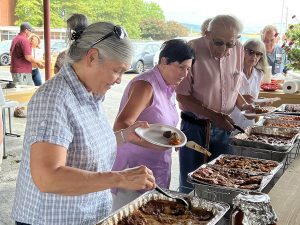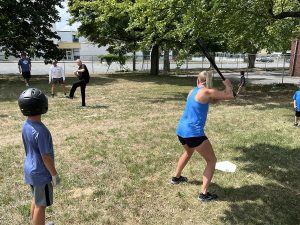
EXETER – Food is known to bring people together and a first-of-its-kind event for two parishes in Luzerne County proved that.
On Sunday, Aug. 21, 2022, the linked parishes of Saint Barbara in Exeter and Corpus Christi in West Pittston held an inaugural covered dish festival. More than 150 people gathered at the outdoor pavilion of Saint Anthony Church in Exeter to enjoy food, fellowship and fun.
After filling their plates with homemade meatballs, hamburgers, pasta salads and desserts, parishioners from both parishes quickly broke down any and all barriers and began socializing and interacting.
“We worship very, very hard. We’re exceptional believers in the faith,” Corpus Christi parishioner Michael Liberski said. “But we also socialize very, very hard too.”
Michael Steinberger, 17, enjoyed the covered dish festival for many reasons.
“It’s not too crowded like a church bazaar,” he explained. “It’s also nice getting to meet new people.”
On May 1, 2022, the two parishes were brought together in a linkage with a single Pastor, Monsignor John J. Sempa of Corpus Christi Parish, after Father Michael E. Finn, Pastor of Saint Barbara Parish retired after 45 years of dedicated and faithful service to the Church of Scranton.
When the linkage was first announced in late February, a small transition team consisting of members from both parishes was established to help guide the process of the two parishes coming together.

“As part of the transition team, we discussed certain ideas that we thought would bring the people together. This was an idea, kind of like a cookout on a Sunday afternoon, and it seems to have been very successful,” Corpus Christi parishioner Carmen Altavilla said.
Altavilla is one of the members of the small transition team.
“We got together and started from the basics, what was going to happen,” he explained.
One of the first topics that had to be tackled was creating a new Mass schedule that could be handled by just one pastor.
“I’m not going to lie to you, there were things we initially disagreed on but I think everybody realized you can’t have it your own way, so we always came to a consensus. That was the big thing,” Altavilla continued. “We had great direction from two women who came from the diocese. They threw out ideas and let us run with things.”
Barbara Russo has been a parishioner at Saint Barbara Parish for 57 years. She currently serves on her parish’s Pastoral Council. Since she belonged to the parish whose pastor was retiring, she admits there was some initial concern about what a ‘linkage’ would entail but said any fear quickly disappeared.
“I think in the beginning there was a little trepidation. We were used to Father Finn who was here nine years,” she explained. “As we got to know Monsignor, he made us feel so comfortable and always, always welcomed us to anything that he had. He said, ‘Let’s come together, let’s come together!’”
Russo credits the welcoming nature of Monsignor Sempa for the two parishes being able to ‘link’ so quickly and effortlessly.
“He said, ‘Don’t worry about it. Everything is going to be okay. Just give it a chance,’ Russo added. “We’re giving it a chance and it’s working beautifully.”
Deacon Walter Janoski, who used to be assigned only to Saint Barbara Parish, expanded his ministry to include Corpus Christi Parish when the linkage began.
“The members of the transition team that were picked were great. What they did is they sat down and informed everybody on what was going on. The first thing Monsignor wanted was a listing of church hours and a Mass schedule. That was probably the hardest thing to determine,” he explained.
Deacon Janoski thinks it is important to highlight the ongoing success of their linkage process so that others around the diocese can see that two parishes can come together with very few issues.
“Because of the transparency, people understood what it all meant,” the clergyman said.
“We talk, we discuss, and there is no fighting, no arguing. The transition team and the councils are working to keep this thing going,” he added.
When asked what he would say to people in other parishes that might soon need to come together in a linkage, Deacon Janoski would simply encourage everyone to “give change a chance.”
“Remember, you are a community. You are not a building. You are a community. You’ve known each other for years,” he said.
From his point of view as a transition team member, Altavilla also answered.
“The problem that a lot of parishes face is they don’t know the other people. What I said from Day One, when we started having meetings, is you can go to any of the three churches that are a part of our parishes because we’re all neighbors. People know one another. It wasn’t like, are you a republican, democrat or independent. It was, we’re all from the same area and we’re going to make this thing work,” he explained. “Everything up until this point has really gone seamless – the interaction, the ministries, sharing the churches. Nobody says, ‘I don’t want to be a Eucharistic Minister at this church, I don’t want to be a lector at that church.’”
As People of God, parishioners also now see the benefit of partnership too.
“I think it means everything. It means now we can work together. We know one another. We’re in such close proximity with one another. Most of us grew up with one another. We went to school together. We had children together. They went to catechism together. Now, we’re coming back together again. It’s renewing our friendship, renewing our faith,” Russo ended by saying.
